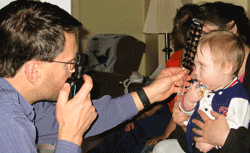Alaska Blind Child Discovery
Confirmatory Eye Exam
Home

Cycloplegic retinoscopy and phoropter in trapeze

ABCD History
Kids Eye Disorders
Amblyopia
Vision Screening
Issues
ABCD Clinics
References
Contact ABCD
Confirmatory Eye Exam following
Vision Screening: Alaska Blind Child Discovery-Exam (ABCD-E)
The purpose of vision screening is to sort children from
“low-risk” to “higher-risk” of pediatric eye disease
for which a confirmatory eye exam is warranted. If the confirmatory exam
yields disease, then treatment is initiated.
A “confirmatory Eye Exam” differs from a “comprehensive
Eye exam” because the child is “high risk” for pediatric
eye disease. The purpose of the Confirmatory exam is to determine if there
are treatable refractive, ocular and/or neurologic conditions.
Here are the parts of the Confirmatory Exam:
1) History: Whether the child has had symptoms of sighs of eye disease
(Warning signs). Whether the child has other health conditions. Whether
the child has ever had treatment of the eye. Birth and developmental history.
Whether there is a family history of eye disorders? Whether there are
any medications or allergies?
2) Acuity: The ability to non-randomly identify the smallest similar figures
(optotypes) at distance. This can be a simple wall chart, or a randomly
presented computer screen or projector. Optotypes may be letters or numbers,
or can be pictures that younger children can identify before they have
learned letters. Many younger children can match letters to a “matching
card” held in their lap. The optotypes might be presented as a single,
isolated letter or object, or may be presented in the middle of a whole
line, or multiple lines, or may be presented with “crowding bars”
around a single optotypes. Crowded or surround optotypes are harder to
detect for a patient with amblyopia. The ABCD Coordinating center, as
a part of involvement with PEDIG, uses the EVA protocol with surround
HOTV optotypes.
3) Pupils: size, shape and reaction of pupils in dim light, and in response
to swinging flashlight and near.
4) Peripheral Field: ability to accurately detect stimuli in the peripheral
fields of each eye independently.
5) Estimate accommodation: dynamic retinoscopy[1] or photoscreening or
autorefraction.
6) Motility:
a. Alignment distance primary gaze cover test or Krimsky Test (deviation
from mid-pupil of corneal light reflex)
b. Alignment near
c. Comitance; influence on alignment of gaze in different cardinal gaze
positions.
d. Presence or absence of nystagmus, and variation due to gaze
7) External: appearance and palpation of lids and orbits and anterior
globe (cornea, sclerae, irides)
8) Ocular media: partial or total obscuration of light transmission (by
cataract, corneal opacity or vitreous debris)
9) Retinae: optic nerve, maculae, peripheral retina and degree of substantial
fundus torsion
10) Cycloplegic refraction: Refractive error (retinoscopy or valid autorefraction)
after thorough instillation of cyclopentolate, scopolamine, homatropine
or atropine, additional drops of re-exam if pupils remain miotic or reactive.
11) ocular tension
12) Assessment: classify as to whether one or more AAPOS Amblyopia Risk
Factors[2] present
A summary of the ABCD-E can be reported on the Alaska Blind Child Discovery-Exam Form (ABCD-EF)
1. Guyton DL, O'Connor G. Dynamic Retinoscopy. Binocular
Vision & Eve Muscle Surgery Quarterly. 1994;9(1):15-17.
2. Donahue S, Arnold R, Ruben JB. Preschool vision screening: What should
we be detecting and how should we report it? Uniform guidelines for reporting
results from studies of preschool vision screening. J AAPOS. 2003;7(5):314-315.


